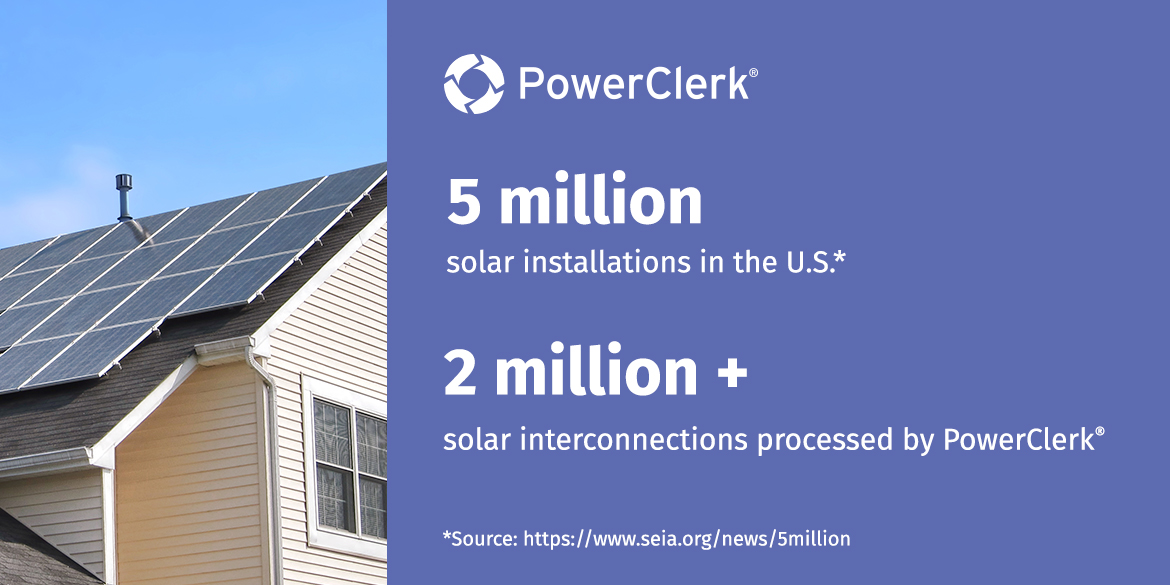The intelligent and coordinated integration of renewable energy projects into power grids is critical for ensuring grid resiliency. Unfortunately, the process of interconnecting these projects is often hindered by disjointed, outdated processes that don’t scale to accommodate modern submission volumes. Interconnection process optimization—from residential rooftop PV to utility-scale solar and wind—is one of many workflows where PowerClerk® is making a difference for utilities nationwide. PowerClerk enables utilities to unify and optimize processes, making them streamlined and more efficient. Utilities using PowerClerk experience shorter turnaround times and backlogs, higher team productivity and stakeholder satisfaction, more transparent project tracking and communication, and more reliable data and reporting.
As the group product manager for PowerClerk, I’m excited to share that PowerClerk has now processed more than two million distributed and utility-scale (e.g., FERC Generator) interconnection projects across the U.S. PowerClerk’s software-as-a-service model delivers continuous enhancements through 40+ releases per year. Recent product innovations aid utilities in adapting to emerging interconnection policies, while also streamlining engineering review and planning processes. The result is accelerated interconnection of renewable energy projects to the grid. Some recent advancements include:
- Cluster study workflow automation – Utilities using PowerClerk can now easily define a group of proposed projects—by connection node or other criteria—and initiate a cluster study workflow. This automation of cluster study workflows saves valuable time, ensures compliance with regulatory standards (such as those in FERC Order No. 2023) and facilitates a smoother interconnection process for energy projects.
- Integration with power engineering software – PowerClerk empowers utilities to develop interconnection workflows that integrate with power engineering software tools such as Eaton’s CYME, EDD’s DEW/ISM, DNV’s Synergi Electric, NREL’s PRECISE™ and more. The integration of these tools supports feasibility assessments, facility evaluations and system impact analyses, enabling a thorough examination of proposed interconnections. Integrating these tools with PowerClerk optimizes efficiency and streamlines interconnection timelines by automating workflows and minimizing manual steps and review cycles. This short video demonstrates a proof-of-concept integration between PowerClerk and CYME.
- Connected ecosystem of integration options – PowerClerk boasts a connected ecosystem of flexible integration options, including REST APIs, Web Adapters, automated Data Import and automated Reports. This ecosystem facilitates seamless integration with systems such as customer information and billing systems (e.g., SAP, Oracle), CRM software (e.g., Salesforce), GIS (e.g., ESRI’s ArcGIS), work order & asset management (e.g., Maximo) and power engineering software tools as noted above. With integrations like these in place, utilities are maximizing their IT investments and optimizing efficiencies by leaning into PowerClerk as the intake portal and workflow automation engine, while letting other systems do what they do best.
- Solar simulations and adoption scenarios – FleetView® uses detailed PV system information collected from PowerClerk interconnection applications combined with industry-leading SolarAnywhere® irradiance data. The output provides utility planners with solar PV system production estimations for proposed and operational PV systems on their grids. Optionally aggregated by feeder circuit, and/or substation, FleetView improves understanding of solar generation variability and unmasks gross loads obscured by behind-the-meter PV. PowerClerk Analytics leverages some of this same data to help planners develop long-term PV and battery adoption scenarios and assess associated grid impacts. Together, these products enhance grid planning and support solar adoption while ensuring continued reliability of the grid.
By automating interconnection workflows, integrating power engineering software studies, fostering a connected ecosystem and leveraging solar production simulations, PowerClerk is driving operational efficiency and compliance in interconnection processes.
To explore some of the ways PowerClerk is creating efficiencies in distributed and utility-scale interconnection workflows, you can read four recent customer-briefs here:
- APS utilizes PowerClerk® to enable efficient, flexible FERC generator interconnection management
- Exelon Companies Gain PV Generation Insights with FleetView
- Rappahannock Electric Co-op (REC) streamlines solar processes
- Streamlining solar interconnection: How JEA leveraged PowerClerk® to resolve its backlog
Utilities and energy agencies can learn more by visiting CleanPower.com or contacting us online.
